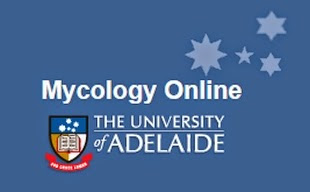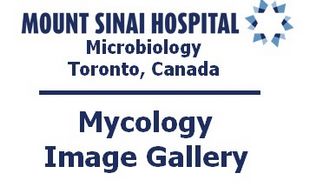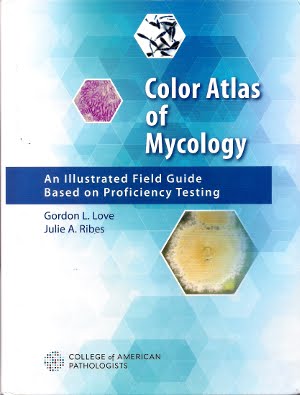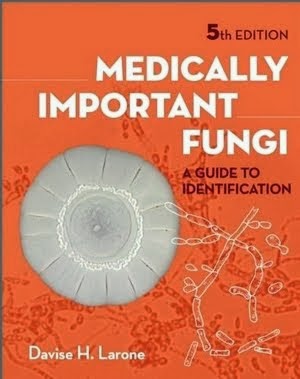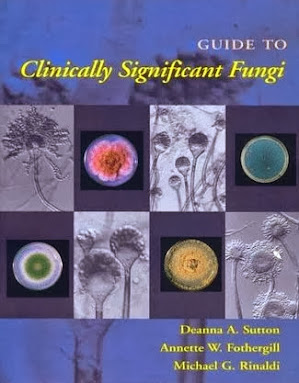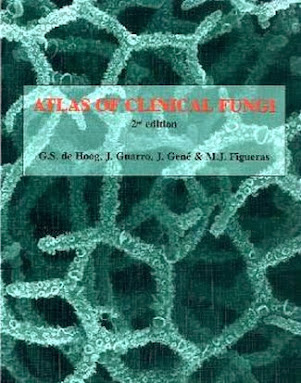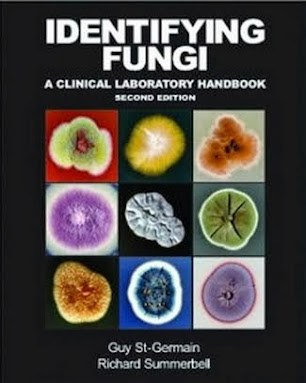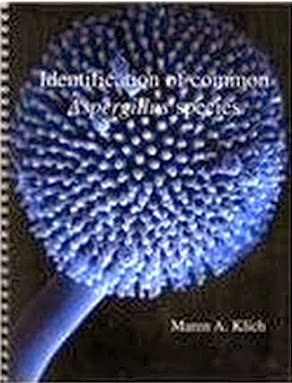Saturday 22 August 2015
Emmonsia pasteuriana
Emmonsia pasteuriana
Note: I've held back on uploading this particular post only because I'm not satisfied with the quality of the photographs I've taken. It is unlikely that I will come across another strain of this fungus in my career so I will post it at this time hoping any readers will understand.
Emmonsia species: Emmonsia currently consists of three
species: E.parva, E.crescens &
E.pasteuriana.
Ecology: Emmonsia is a cosmopolitan soil saprobe
(found just about in all temperate climates and lives of decaying organic
matter). It has been isolated from a
variety of mammalian species, particularly small rodents.
Pathogenicity: Emmonsia
parva and Emmonsia crescens are
the etiologic agents of adiaspiromycosis.
Usually this presents as an asymptomatic pulmonary infection in animals,
and more recently in immunocompromised humans after the inhalation of the
fungal spores. Lung biopsy may be necessary to diagnose the illness as the
organisms may not be present in sputa or bronchial alveolar lavages. Dissemination of the infection may occur more
readily in immunocompromised hosts. E.crescens
is more commonly isolated from humans while E.parva is isolated more often from animals.
Reports of E.pasteuriana
have increased in recent years, presenting as disseminated cutaneous (skin)
mycosis in persons with underlying AIDS infections[i]. Unlike E.parva
and E.crescens, E.pasteuriana does not produce adiaconidia and therefore does not
cause adiaspiromycosis. E. pasteuriana
appears as yeast in infected tissue.
Emmonsia pasteuriana:
Macroscopic
Morphology: E.pasteuriana exhibits slow to moderate growth at 30ᵒC, with a
colony diameter of about 25mm after 10 days and 60mm after 21 days. The colony appeared velvety to powdery in
texture with folded, wrinkled, or cerebriform surface contours. The colony
spontaneously acquired splits in the surface as it aged (see photo) The colony
was primarily white in colour and remained so while some sources state that it
may develop a light brown colour as it ages.
The colony produced no diffusible pigment. The reverse was tan or light brown in colour.
Emmonsia pasteuriana - Saboraud-Dextrose Agar. The splits in the colony were created by the growth and not by any prodding of my own. (SAB), 30ᵒC, 1 Month. (Nikon)
Emmonsia pasteuriana - Dermasel® agar, 30ᵒC, ~18 Days. (Nikon)
Microscopic
Morphology: Emmonsia
pasteuriana is a dimorphic fungus meaning it can exhibit the filamentous
fungus form at one temperature and the yeast form at another.
Filamentous form:
This isolate produce septate, hyaline (non-pigmented) hyphae of about 1.0 to 1.3
µm diameter. Thin-walled, slightly
verruculose (minutely verrucose or warty), globose to sub-globose (round-ish) conidia
(2 – 3 µm X 3 – 4 µm) are formed on slender (0.4 – 0.5 µm) pedicles (stalks) or
at the apex of inflated cells. Initially
a conidium may be found at the end of a delicate pedicle which may then develop
further to form four to eight pedicles with conidia, establishing a ‘floret’. Additional sessile or broad-based verrucose
(warty) conidia may also be present.
Emmonsia pasteuriana - hyphae with conidia visible throughout.
(400X, LPCB, DMD-108)
Emmonsia pasteuriana - Globose to sub-globose (round-ish) conidia. They are generally found at the end of a delicate pedicile (stem) which can barely be seen at this magnification. A few more photos to follow of much the same as this is this really was my first impression of this fungus and what clued me into what it might be.
(400X, LPCB, Nikon)
Emmonsia pasteuriana - ditto. Numerous conidia formed.
(400X, LPCB, Nikon)
Emmonsia pasteuriana - another as previously, but here in this photo there may be evidence of the conidia occuring in small bunches, each on its own pedicile branching off from a central delicate pedicile. (400X, LPCB, Nikon)
Emmonsia pasteuriana -small conidia occuring in bunches (as previously)
(400X, LPCB, Nikon)
Emmonsia pasteuriana - and another.
(400X, LPCB, Nikon)
Emmonsia pasteuriana -at a higher magnification, the rather round (globose) or 'round-ish' (sub-globose) conidia can be seen with a couple at the end of a pedicile (stem or stalk) and one (center-left) which may be growing directly from the hypha (sessile).
(1000X, LPCB, DMD-108)
Emmonsia pasteuriana -small clusters of conidia.
(1000X, LPCB, DMD-108)
Emmonsia pasteuriana - as above. It was my impression of the tiny, round conidia attached by a delicate pedicile which directed me to the identity.
(1000X, LPCB, DMD-108)
Emmonsia pasteuriana - a solitary conidium at the end of a pedicile is seen in this photo (inset)
(1000X, LPCB, DMD-108)
Emmonsia pasteuriana - Initially
a conidium may be found at the end of a delicate pedicle (see above) which may then develop
further to form four to eight pedicles with conidia, establishing a ‘floret’. Here we see more distinctly what is described as a 'floret' (inset).
(400+10X, LPCB, DMD-108)
Emmonsia pasteuriana -a very good example of the 'floret', usually composed of between 4 to 8 conidia at the end of the slender delicate and slender (0.4 – 0.5 µm) pedicles.
(1000X, LPCB, Nikon)
Emmonsia pasteuriana -another example of a 'floret' as above.
(1000X, LPCB, DMD-108)
Emmonsia pasteuriana -a string of florets along a delicate hyaline (non-pigmented) hypha of about of about 1.0 to 1.3
µm diameter running through the photo from lower left to upper right.
(1000X, LPCB, Nikon)
Emmonsia pasteuriana -a string of florets along delicate hyaline (non-pigmented) hyphae.
(400X, LPCB, Nikon)
Emmonsia pasteuriana - Additional sessile (directly from hypha) or broad-based verrucose
(warty) conidia may also be produced.
(1000X. LPCB, Nikon)
Emmonsia pasteuriana - once again, single conida on slender stalks.
(400X, LPCB, DMD-108)
Emmonsia pasteuriana - two conidia can be seen at center left, attached to the delicate pedicile.
(400+10X, LPCB, DMD-108)
Emmonsia pasteuriana -sessile (directly from hypha) or broad-based verrucose
(warty) conidia may be produced. (1000X, LPCB, DMD-108)
Emmonsia pasteuriana - Once again, thin-walled, slightly
verruculose (minutely verrucose or warty), globose to sub-globose (round-ish) conidia
(2 – 3 µm X 3 – 4 µm) are formed on slender (0.4 – 0.5 µm) pedicles (stalks) or
at the apex of inflated cells. Here in this photo is a conidium at the apex of an inflated cell. (1000+10X, LPCB, DMD-108)
Emmonsia pasteuriana - more conidia at the born on delicate pediciles.
(1000X, LPCB, DMD-108)
Yeast form: The filamentous fungus form can be converted
to the yeast form by incubating a freshly inoculated culture at 37ᵒC for 10 to
14 days. Conversion is enhanced by
cultivation on the nutritionally richer Brain-Heat Infusion (BHI) agar. Smooth, butyrous colonies appear cream to
beige in colour which may darken as they age.
Colonies consist of globose to oval yeast colonies which may show
narrow-based budding.
Emmonsia pasteuriana - isolate was inoculated onto Brain-Heart Infusion (BHI) agar and incubated at 37ᵒC for 14 days. Emmonsia pasteuriana converted to the yeast form which is the form that is directly recovered from skin lesions.
(400X, LPCB, DMD-108)
Emmonsia pasteuriana - a more convincing example of the yeast-like phase of E.pasteuriana.
(400+10X, LPCB, DMD-108)
Note: At various stages of development, Emmonsia species may resemble other
fungi such as Blastomyces dermatitidis,
Paracoccidioides brasiliensis, Histoplasma capsulatum and Chrysosporium species. It has been noted that some cross-reaction
(false positives) may occur between Emmonsia
species and Blastomyces dermatitidis
with a both a DNA probe and direct immunofluorescent-antigen tests.
Adioconidia:
When the hyphae and conidia are incubated at their maximum temperatures on
enriched media, the hyphae become distorted and usually disintegrate while the
conidia swell to become round, thick-walled adiaconidia (formerly called
adiaospores). Production of adiaconidia
is best achieved by incubation at increased temperatures: 37ᵒC for E.crescens (20 – 14 µm dia) and at 40ᵒC
for E.parva (10 -25 µm dia). As
previously mentioned, E.pasteuriana cannot
be induced to produce adiaconidia at any temperature.
Physiology: Emmonsia
pasteuriana is not inhibited by cycloheximide and therefore can be grown on
Mycosel® or Dermasel® agar.
[i] A
Dimorphic Fungus Causing Disseminated Infection in South Africa
Chris Kenyon M.D. et al.,
N.Engl. J. Med. 2013, 369 – 1416 - 1424
Saturday 1 August 2015
Penicillium citrinum
Penicillium citrinum
Ecology: Penicillium
citrinum is a commonly occurring filamentous fungus with worldwide
distribution. It has been isolated from
a variety of sources including soils, decaying vegetation, foodstuffs (beans,
coffee, cereals & spices) as well as a variety of indoor environments.
Pathology: While Penicillium
species are generally regarded as laboratory contaminants, or at best,
opportunists, a number of species have been implicated as being involved in the
disease process. While Penicillium
species may be isolated from clinical specimens, it is commonly believed that a
true infection can only be established by histological demonstration of tissue
invasion. With that in mind, Penicillium
citrinum has been reported in mycotic keratitis (eye), lung infections
(pneumonia), a single case of a urinary tract infection (UTI) and one of
pericarditis. Their contribution to the
disease process may be secondary an additional underlying illness. As with all fungi, immunocompromised
individuals may be at greater risk of infection including those rarely
considered as pathogenic.
 Macroscopic
Morphology: Penicillium citrinum exhibits moderately slow growth on
Sabouraud-Dextrose agar (SAB) at 30ᵒC.
Surface texture is velutinous (soft, velvety surface) to floccose
(woolly tufts of soft “hairs”). The
colonial growth appears radially sulcate (narrow, deep furrows or radial
grooves –like spokes on a wheel). The
mature colony has a central greyish-turquoise to greyish-orange colour with a
white periphery (outer edge). Exudates
(extrolites) are frequently produced which appear as drops of liquid upon the
surface of the colony. These may appear
clear, to pale yellow, to a reddish-brown in colour. Some strains may also produce a soluble
pigment which can diffuse into the surrounding medium. The reverse is a pale yellow to a light
yellow-brown. Colours and growth characteristics are, of course, media and
strain dependent.
Macroscopic
Morphology: Penicillium citrinum exhibits moderately slow growth on
Sabouraud-Dextrose agar (SAB) at 30ᵒC.
Surface texture is velutinous (soft, velvety surface) to floccose
(woolly tufts of soft “hairs”). The
colonial growth appears radially sulcate (narrow, deep furrows or radial
grooves –like spokes on a wheel). The
mature colony has a central greyish-turquoise to greyish-orange colour with a
white periphery (outer edge). Exudates
(extrolites) are frequently produced which appear as drops of liquid upon the
surface of the colony. These may appear
clear, to pale yellow, to a reddish-brown in colour. Some strains may also produce a soluble
pigment which can diffuse into the surrounding medium. The reverse is a pale yellow to a light
yellow-brown. Colours and growth characteristics are, of course, media and
strain dependent.
Penicillium citrinum-SAB, 14 days incubation at 30ᵒC (Nikon)
Note the drops of exudate (extrolites) which have formed on the surface.
Colour variation due to maturing of colony but also a difference in my lighting for photography.
Exudates (or
Extrolites): Some fungi can produce exudates as a by-product of their
growth, many of which can be collected for commercial use. Mycotoxins are by-products (secondary
metabolites) which are potent poisons.
Penicillium citrinum produces Citrinin, a nephrotoxic mycotoxin which
derives its name from the fungus. It may
also produce other extrolites such as tanzowaic acid A, quinolactacins,
quinocitrinines, asteric acid and compactin.
Microscopic
Morphology: Penicillium citrinum
produces septate, hyaline (clear, not pigmented) hyphae. Smooth-walled conidiophores stipes are rather
long (100 – 300 µm) and is biverticillate (see diagram at end of post). Metulae are 12 – 15 µm in length which are
found in whorls of 3 – 5 divergent structures.
Phialides are ampuliform (flask-shaped) and about 7 – 12 µm in
length. Conidia (2.2 – 3.0 µm dia.) are
globose to sub-globose (round to off-round) and are smooth or have a finely
roughened surface. Conidia resist disruption
and form rather long chains. These
characteristics: the metulae longer than the phialides and the conidia being
both spherical and produced in well-defined chains, are distinguishing features
of Penicillium citrinum.
Penicillium citrinum- distinguishing features of Penicillium 'species' can already be made out at low magnification. (250X, LPCB, DMD-108)
Penicillium citrinum- distinguishing features of Penicillium 'species' much more evident at 400X.
Typical "fingers" made up of the metulae and phialide structures from which chains of conidia extend. (400X, LPCB, DMD-108)
Penicillium citrinum- a mass of overlapping fruiting structures with copious amounts of conidia.
(1000X, LPCB, DMD-108)
Penicillium citrinum- a little less congested in this photo. Conidiophores (stipes) seen from which extend the metulae and conidia producing phialides. Conidia are globose (round) to sub-globose (somewhat off-round) in shape, (1000X, LPCB, DMD-108)
Penicillium citrinum- long metulae and the somewhat shorter phialides are clearly distinguishable in this photograph. The conidia are generally smooth or can have a finely roughened surface.
(1000+10X, LPCB, DMD-108)
Penicillium citrinum- another view.
(1000+10X, LPCB, DMD-108)
Penicillium citrinum- exhibits biverticillate branching meaning that the conidiophore can branch and the metulae & phialides extend from these branches. Triverticillate would have the conidia branching and then the branches also branching to finally produce the metulae & phialide fruiting structures.
(1000X, LPCB, DMD-108)
Penicillium citrinum- Phialides are ampuliform (flask-shaped) and about 7 – 12 µm in
length. Again, conidia (2.2 – 3.0 µm dia.) are
globose to sub-globose (round to off-round) and are smooth or have a finely
roughened surface. (1000+10X, LPCB, DMD-108)
Penicillium citrinum- Here we see the proportions of the metulae (M) and the 'flask-shaped' phialides (P) with the metulae being substantially longer than the phialides, The biverticillate structure is evident in this photo. (ie. each branch extending from the conidiophore (stipe), branches only once and then bears a fruiting structure consisting of the metulae and phialides.
(1000+10X, LPCB, DMD-108)
Penicillium citrinum- another example.
(1000+10X, LPCB, DMD-108)
Penicillium citrinum- a few more photos to finish up.
(1000+10X, LPCB, DMD-108)
Penicillium citrinum- suitable for framing!
(1000X, LPCB, DMD-108)
Penicillium citrinum
(400+10X, LPCB, DMD-108)
Penicillium citrinum
(400X, LPCB, DMD-108)
Penicillium citrinum- another colony showing the exudate (extrolites) which accumulate on the colony surface after extended incubation. These metabolites may be potent poisonous mycotoxins or might have beneficial uses in industrial or pharmaceutical applications. (Nikon)

Physiology: The spores of Penicillium citrinum fail to
germinate at 5ᵒC and may show restricted growth at 37ᵒC.
* * *
Labels:
Biverticillate,
extrolites),
exudates,
metulae,
Penicillium citrinum,
phialides
Subscribe to:
Posts (Atom)












































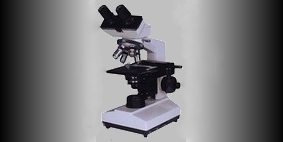.jpg)










